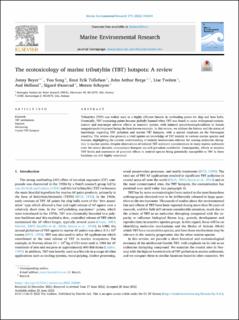| dc.contributor.author | Beyer, Jonny | |
| dc.contributor.author | Song, You | |
| dc.contributor.author | Tollefsen, Knut-Erik | |
| dc.contributor.author | Berge, John Arthur | |
| dc.contributor.author | Tveiten, Lise Ann | |
| dc.contributor.author | Helland, Aud | |
| dc.contributor.author | Øxnevad, Sigurd | |
| dc.contributor.author | Schøyen, Merete | |
| dc.date.accessioned | 2022-09-21T12:09:37Z | |
| dc.date.available | 2022-09-21T12:09:37Z | |
| dc.date.created | 2022-09-05T10:52:50Z | |
| dc.date.issued | 2022 | |
| dc.identifier.citation | Marine Environmental Research. 2022, 179, 105689. | en_US |
| dc.identifier.issn | 0141-1136 | |
| dc.identifier.uri | https://hdl.handle.net/11250/3020219 | |
| dc.description.abstract | Tributyltin (TBT) was widely used as a highly efficient biocide in antifouling paints for ship and boat hulls. Eventually, TBT containing paints became globally banned when TBT was found to cause widespread contamination and non-target adverse effects in sensitive species, with induced pseudohermaphroditism in female neogastropods (imposex) being the best-known example. In this review, we address the history and the status of knowledge regarding TBT pollution and marine TBT hotspots, with a special emphasis on the Norwegian coastline. The review also presents a brief update on knowledge of TBT toxicity in various marine species and humans, highlighting the current understanding of toxicity mechanisms relevant for causing endocrine disruption in marine species. Despite observations of reduced TBT sediment concentrations in many marine sediments over the recent decades, contaminant hotspots are still prevalent worldwide. Consequently, efforts to monitor TBT levels and assessment of potential effects in sentinel species being potentially susceptible to TBT in these locations are still highly warranted. | en_US |
| dc.language.iso | eng | en_US |
| dc.publisher | Elsevier | en_US |
| dc.rights | Navngivelse 4.0 Internasjonal | * |
| dc.rights.uri | http://creativecommons.org/licenses/by/4.0/deed.no | * |
| dc.title | The ecotoxicology of marine tributyltin (TBT) hotspots: A review | en_US |
| dc.type | Peer reviewed | en_US |
| dc.type | Journal article | en_US |
| dc.description.version | publishedVersion | en_US |
| dc.rights.holder | © 2022 The Authors | en_US |
| dc.source.pagenumber | 14 | en_US |
| dc.source.volume | 179 | en_US |
| dc.source.journal | Marine Environmental Research | en_US |
| dc.identifier.doi | 10.1016/j.marenvres.2022.105689 | |
| dc.identifier.cristin | 2048774 | |
| dc.relation.project | Norges forskningsråd: 268294 | en_US |
| dc.source.articlenumber | 105689 | en_US |
| cristin.ispublished | true | |
| cristin.fulltext | original | |
| cristin.qualitycode | 2 | |

